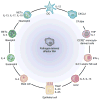Innate cell communication kick-starts pathogen-specific immunity
- PMID: 27002843
- PMCID: PMC4949486
- DOI: 10.1038/ni.3375
Innate cell communication kick-starts pathogen-specific immunity
Abstract
Innate cells are responsible for the rapid recognition of infection and mediate essential mechanisms of pathogen elimination, and also facilitate adaptive immune responses. We review here the numerous intricate interactions among innate cells that initiate protective immunity. The efficient eradication of pathogens depends on the coordinated actions of multiple cells, including innate cells and epithelial cells. Rather than acting as isolated effector cells, innate cells are in constant communication with other responding cells of the immune system, locally and distally. These interactions are critically important for the efficient control of primary infections as well for the development of 'trained' innate cells that facilitate the rapid elimination of homologous or heterologous infections.
Conflict of interest statement
The authors declare no competing financial interests.
Figures




Similar articles
-
Cytokine Networks between Innate Lymphoid Cells and Myeloid Cells.Front Immunol. 2018 Feb 7;9:191. doi: 10.3389/fimmu.2018.00191. eCollection 2018. Front Immunol. 2018. PMID: 29467768 Free PMC article. Review.
-
Human Respiratory Syncytial Virus: Role of Innate Immunity in Clearance and Disease Progression.Viral Immunol. 2016 Jan-Feb;29(1):11-26. doi: 10.1089/vim.2015.0098. Epub 2015 Dec 17. Viral Immunol. 2016. PMID: 26679242 Review.
-
Innate immune memory in mammals.Semin Immunol. 2016 Aug;28(4):351-8. doi: 10.1016/j.smim.2016.05.003. Epub 2016 Jun 2. Semin Immunol. 2016. PMID: 27264334 Review.
-
Human innate immunosenescence: causes and consequences for immunity in old age.Trends Immunol. 2009 Jul;30(7):325-33. doi: 10.1016/j.it.2009.05.004. Epub 2009 Jun 21. Trends Immunol. 2009. PMID: 19541535 Free PMC article. Review.
-
Innate Immunity Effector Cells as Inflammatory Drivers of Cardiac Fibrosis.Int J Mol Sci. 2020 Sep 28;21(19):7165. doi: 10.3390/ijms21197165. Int J Mol Sci. 2020. PMID: 32998408 Free PMC article. Review.
Cited by
-
FPR1 signaling aberrantly regulates S100A8/A9 production by CD14+FCN1hi macrophages and aggravates pulmonary pathology in severe COVID-19.Commun Biol. 2024 Oct 14;7(1):1321. doi: 10.1038/s42003-024-07025-4. Commun Biol. 2024. PMID: 39402337 Free PMC article.
-
Role of heterogeneous cell population on modulation of dendritic cell phenotype and activation of CD8 T cells for use in cell-based immunotherapies.Cell Immunol. 2017 Jan;311:54-62. doi: 10.1016/j.cellimm.2016.10.004. Epub 2016 Oct 13. Cell Immunol. 2017. PMID: 27793335 Free PMC article.
-
The Notch signaling pathway promotes basophil responses during helminth-induced type 2 inflammation.J Exp Med. 2019 Jun 3;216(6):1268-1279. doi: 10.1084/jem.20180131. Epub 2019 Apr 11. J Exp Med. 2019. PMID: 30975892 Free PMC article.
-
COVID-19 severity in obese patients: Potential mechanisms and molecular targets for clinical intervention.Obes Res Clin Pract. 2021 Mar-Apr;15(2):163-171. doi: 10.1016/j.orcp.2021.01.004. Epub 2021 Jan 19. Obes Res Clin Pract. 2021. PMID: 33509701 Free PMC article. Review.
-
Succinate and inosine coordinate innate immune response to bacterial infection.PLoS Pathog. 2022 Aug 26;18(8):e1010796. doi: 10.1371/journal.ppat.1010796. eCollection 2022 Aug. PLoS Pathog. 2022. PMID: 36026499 Free PMC article.
References
-
- Patel N, et al. A2B adenosine receptor induces protective antihelminth type 2 immune responses. Cell Host Microbe. 2014;15:339–350. - PubMed
Publication types
MeSH terms
Substances
Grants and funding
- R01 AI107588/AI/NIAID NIH HHS/United States
- R01AI083405/AI/NIAID NIH HHS/United States
- R21 CA167238/CA/NCI NIH HHS/United States
- 1R01AI107588/AI/NIAID NIH HHS/United States
- K22 AI110573/AI/NIAID NIH HHS/United States
- 1R01AI123224/AI/NIAID NIH HHS/United States
- R01 AI083405/AI/NIAID NIH HHS/United States
- K22 AI110573-01/AI/NIAID NIH HHS/United States
- R01 AI114647/AI/NIAID NIH HHS/United States
- R01AI114647-01A1/AI/NIAID NIH HHS/United States
- R21CA167238-01A1/CA/NCI NIH HHS/United States
- R01 AI123224/AI/NIAID NIH HHS/United States
LinkOut - more resources
Full Text Sources
Other Literature Sources

